Overclocking The AMD Ryzen APUs: Guide and Results
by Ian Cutress & Gavin Bonshor on April 16, 2018 2:30 PM ESTHow to Overclock With MSI UEFI BIOS
The MSI UEFI BIOS is aesthetically pleasing and is easy to navigate around. The core features between the board being used for testing today, the MSI B350I Pro AC, and other models in their AM4 line up such as the X370 XPOWER GAMING TITANIUM are the same, with the same options for adjusting CPU core voltage, DRAM voltage and for the iGPU. It needs to be noted that the GFX Core voltage and CPU NB/SoC voltages are linked together; only one of them needs to be adjusted.
Hitting the Del key during system POST will get you into the first screen. The first screen is what MSI call ‘EZ mode’ which offers the basic panels for making minor adjustments.
Pressing F7 opens up the advanced section.
This offers high-level tabs for settings, OC and M-Flash. The overclocking panel is on the left, giving rise to the voltage parameters, CPU frequency multipliers, memory frequency, and the iGPU options.
On this particular board, all the options that need to be changed are all featured on the entry screen when the OC tab is selected. The CPU ratio can be adjusted by pressing +/- keys or by typing in a value. Voltage is in the Voltage Setting category a few options down, and is by default set to auto. For memory, XMP (shown as A-XMP) was set to profile 1 to enable DDR4-3333 mode.
The CPU core voltage options in the BIOS can only apply a maximum of 1.4 volts. Users looking to apply more can use the AMD Ryzen Master Utility which will allow for up to 1.55 V, although this is too much for ambient cooling and we would not recommend it. For our testing, this was set to 1.375 volts to match with our test setup and methodology settings. The memory voltage was manualy set to 1.35 volts to ensure it matched the specifications of our G.Skill Ripjaws DDR4’s first XMP profile.
Overclocking the graphics on our AMD Ryzen 3 2200G APU was also as easy as the rest, with the only settings needing changing is the GFX clock frequency, which we set to 1375 MHz.
When it comes to setting the voltages for the integrated graphics processor, the SoC voltage and the graphics voltage are linked, so changing one changes the other.
Once the settings are chosen, pressing F10 will bring up a summary of the changes made since the system was booted. Selecting yes will cause the system to reboot with the new settings.
Note: AMD’s Cool’n’Quiet function is automatically disabled on MSI motherboards when the CPU ratio is changed. Also, when OC explore mode is set from normal to expert, it opens up a setting called memory retry count. This is handy when manually overclocking memory as it will attempt to POST with a set variable amount, which automatically defaults at 5.


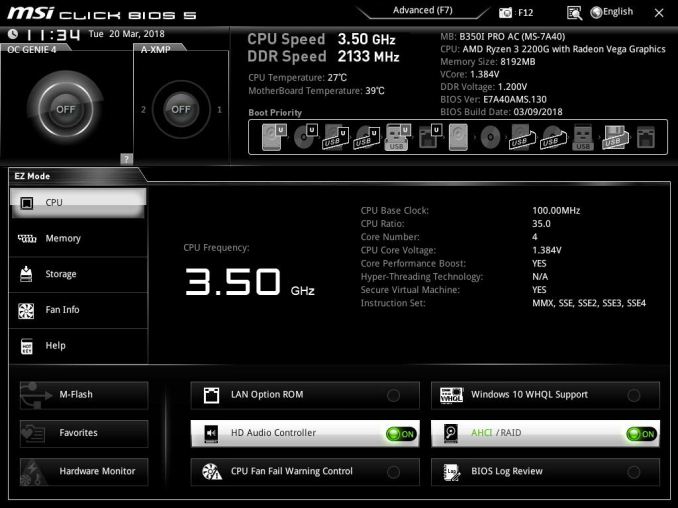
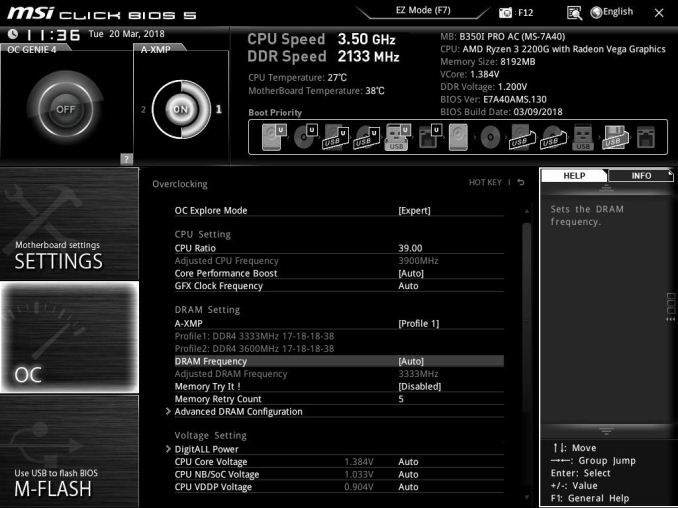
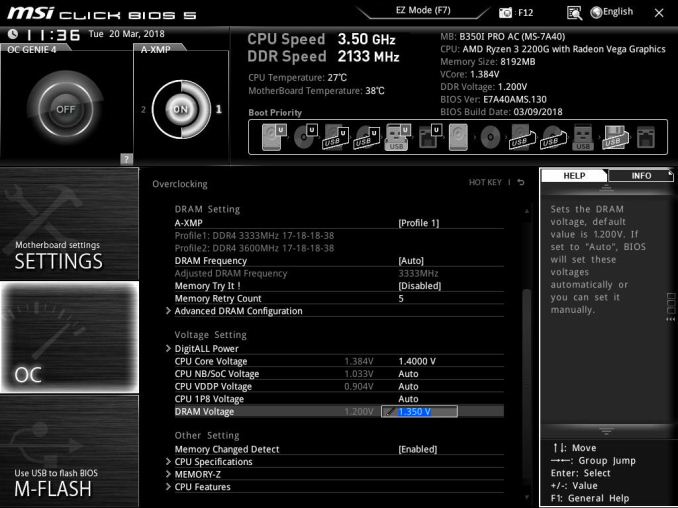
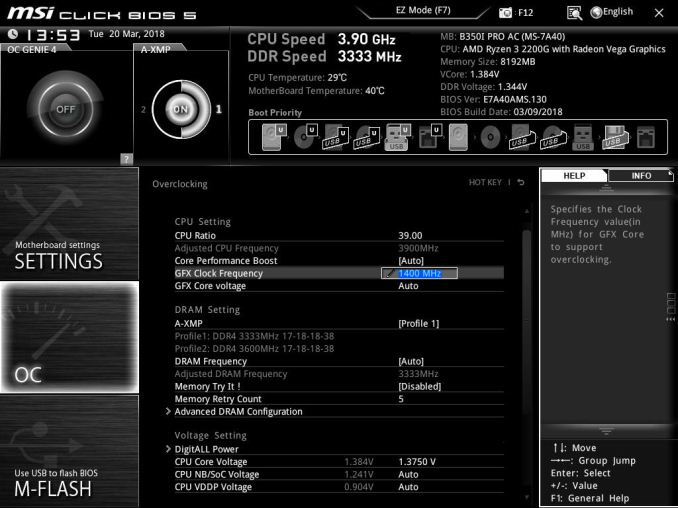
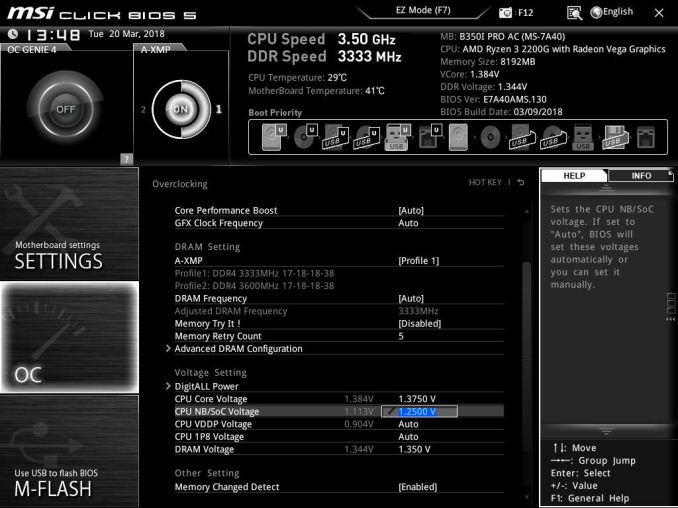
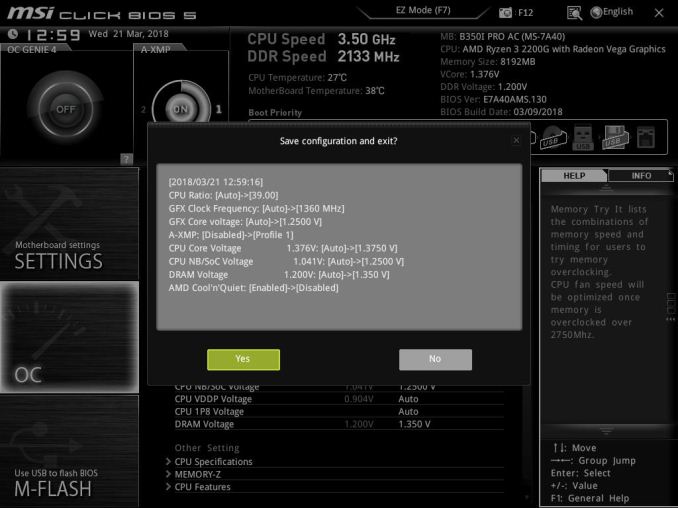








63 Comments
View All Comments
JoeyJoJo123 - Monday, April 16, 2018 - link
You pay more for the MiniITX formfactor, in both case cost, SFX PSU cost, and motherboard feature compaction costs. Check out PcPartPicker to organize a parts list. I'd recommend just sticking with whichever X370 or X470 board is cheapest and well rated, and choosing a cheap (~$60 or less) but well rated case to go along with that. 80+ Bronze ~400W PSUs from a reputable manufacturer are cheap.With the savings you can splurge a bit on faster/more memory or a FreeSync enabled or high refresh rate display, or nicer peripherals, all of which at the end of the day provide a more meaningful impact on a day-to-day basis than just having a "tiny" PC.
Alexvrb - Wednesday, April 18, 2018 - link
There are tons of mITX cube cases that are affordable and use standard PSUs. You also get WiFi included, and if you choose your board carefully you get GOOD WiFi included.Alexvrb - Monday, April 16, 2018 - link
I just built a system using the board you just linked, for my dad. Using the 2200G too. It's a peppy little system. The board has been solid (I bought it in March and it was already 2000-ready, but flash it anyway as the newer BIOS has fixes and better RAM support). BIOS seems decent. It also has pretty good Intel WiFi preinstalled, and a decent antenna. Installed the latest driver straight from Intel. A lot of ITX boards use CRAP wifi that is unreliable with poor drivers. This saved me from having to swap wifi chips.I also got a good deal on a 2 x 8GB kit. Team T-Force Dark 3000 kit, CL16.
https://www.newegg.com/Product/Product.aspx?Item=N...
It's overkill since he doesn't game but I got it on sale and faster RAM is never a bad thing. All I did was kick on the XMP profile and it works flawlessly. Even faster RAM shouldn't be a problem either for Raven Ridge but once you get above a certain point you have to start thinking about what memory dies and configuration you're looking at. If you're planning on running integrated for a bit you could overclock the IGP and get somewhat faster RAM.
Lolimaster - Tuesday, April 17, 2018 - link
I would get a new X470, the memory managament seems to be better.Asus X470-Pro
Lolimaster - Tuesday, April 17, 2018 - link
For PSU Seasonic S12-II 520w Bronze, a champ of efficiency at low loads (80%+ at 10% load were even platinum PSU's fail hard).Alexvrb - Wednesday, April 18, 2018 - link
He's obviously building a budget rig. Until B450 mITX boards show up, you're in a different league entirely in terms of price.mr_tawan - Tuesday, April 17, 2018 - link
I am looking at this mainboard as well. I'm aiming for SkyReach 4 mini for case and HDPlex 160W, which are quite expensive but it's quite attractive (at least for me). I'd put the Ryzen 3 2200g and a pair of DDR4 (not decided yet) and call it a stelth rig :).That said, I am actually thinking about getting a laptop instead, but laptop is not as stelth-ey as a small pc form factor IMHO :).
mr_tawan - Tuesday, April 17, 2018 - link
oh and a stick of M.2 Samsung 860EVO for storage. 120GB maybe ...Amandtec - Tuesday, April 17, 2018 - link
The integrated video scales almost linearly with memory speed so try to buy faster memory and get 2x4gb rather than 1x8gb. Also, one video showed a $20 fan vastly outperforming the standard one for overclocking. So for about an extra 10% cost or $40 you can get up to 30% performance improvement.Lolimaster - Tuesday, April 17, 2018 - link
You can reuse the heatsink on basically any other build or future APU.CM Hyper 212X is the champ. Also silent operation, totally worth it.